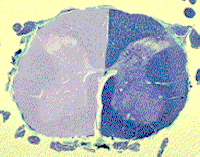|
Introduction
| Case 1 | Case
2 | Case 3 | Case
4 | Case 5 | Case
6
Case
1.
A 24 year
old male was brought into the emergency room following a motorcycle
accident. He suffered an apparent fracture of the spine in the
lower back region. Neurological examination revealed the following:
- spastic
paralysis of the lower left limb;
- increased
deep tendon reflexes of the lower left limb;
- Babinski
sign on the left;
- loss of
position sense, touch and pressure sensations of the lower left
limb;
- complete
anesthesia of the L2 dermatome on the left side;
- loss of
pain sensations and thermal anesthesia of the L3-S4 dermatomes on
the right side.
 Case
1 is a classic example of the Brown Sequard Syndrome.
Damage to the left side of the cord produces the symptoms of an upper
motor neuron disease in the left lower limb since the lateral cortical
spinal tract has been severed on the left side of the cord (the descending
cortical spinal tract has already crossed in the lower medulla at
the decussation of the pyramids). Complete loss of sensation
on the left side at the L2 dermatome indicates that the injury is
at the level of the second lumbar segment of the cord. This
is confirmed by the "crossed" loss of different sensations
below the L2 dermatome. Loss of proprioception and fine touch
on the lower left limb is due to damage to the fasciculus gracilis
on the left side of the cord. These modes of somatosensory information
ascending toward the brainstem have not yet crossed. On the
other hand, loss of pain and temperature in the right lower limb is
due to damage to the anterior spinal thalamic tract on the left
side - remembering that these modes of somatosensory information immediately
cross in the anterior white commissure. Case
1 is a classic example of the Brown Sequard Syndrome.
Damage to the left side of the cord produces the symptoms of an upper
motor neuron disease in the left lower limb since the lateral cortical
spinal tract has been severed on the left side of the cord (the descending
cortical spinal tract has already crossed in the lower medulla at
the decussation of the pyramids). Complete loss of sensation
on the left side at the L2 dermatome indicates that the injury is
at the level of the second lumbar segment of the cord. This
is confirmed by the "crossed" loss of different sensations
below the L2 dermatome. Loss of proprioception and fine touch
on the lower left limb is due to damage to the fasciculus gracilis
on the left side of the cord. These modes of somatosensory information
ascending toward the brainstem have not yet crossed. On the
other hand, loss of pain and temperature in the right lower limb is
due to damage to the anterior spinal thalamic tract on the left
side - remembering that these modes of somatosensory information immediately
cross in the anterior white commissure.
It is unlikely
that these deficits would be seen immediately following the accident.
In fact, it is more likely that flaccid paralysis and the absence
of reflexes would be noted at and below the lesion. This is
due to spinal shock, which may be a function of the sudden
loss of numerous descending modulatory influences on motor function
whose net effect are facilatory in maintaining motor tone.
It may take from days to weeks to recover from this shock depending
upon the nature and extent of the damage. It is important to
remember that during this period that loss of bladder function and
sensation of bladder fullness can become complicating factors.
Until reflexes recover, early catherization is required to minimize
distention, infection and damage.
 
|